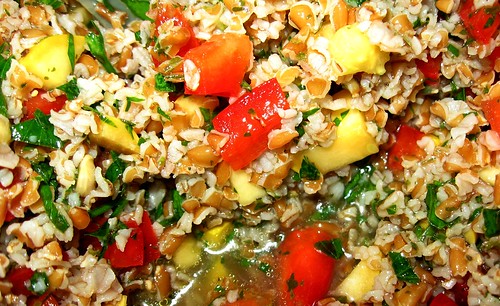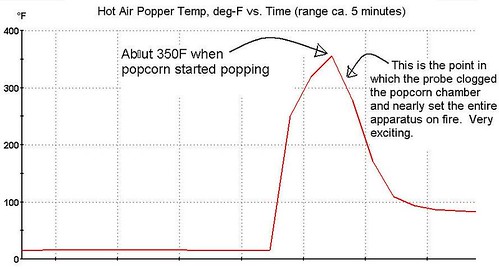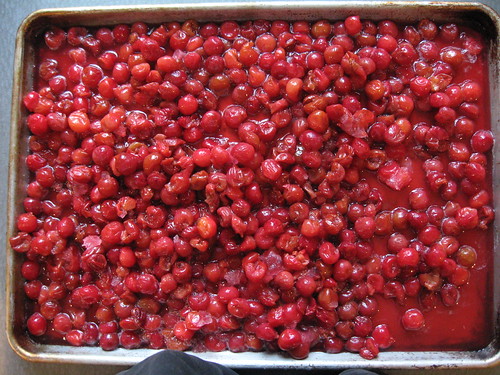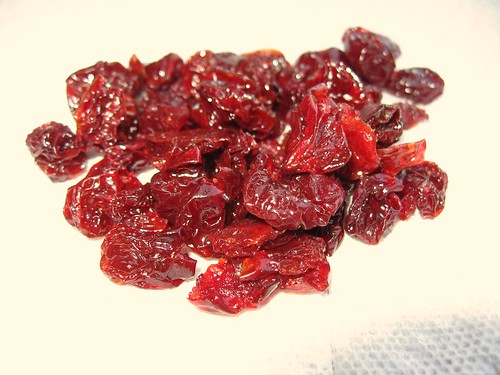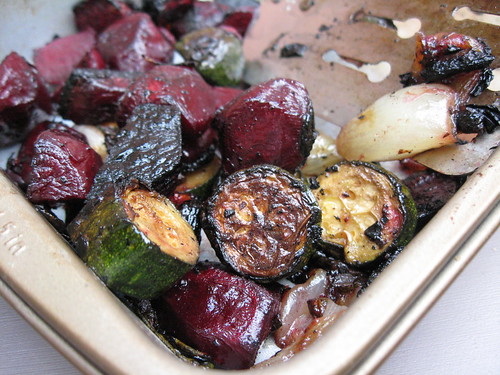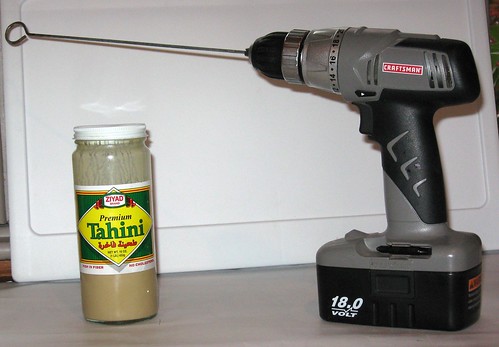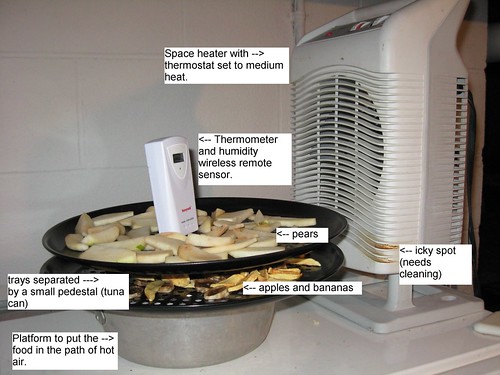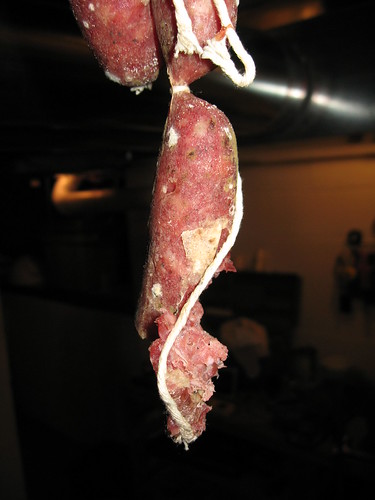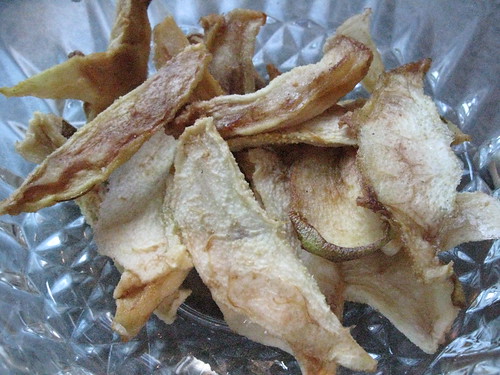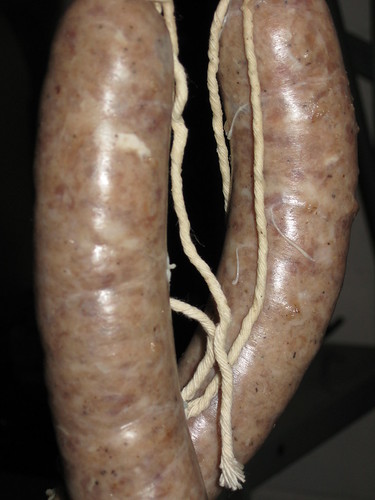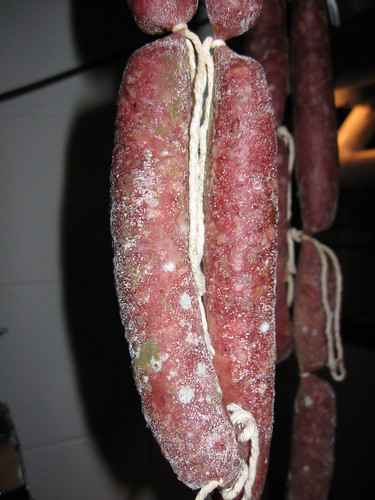7.22.2008
Vegged up Tabouleh
We do weekly menu planning 'round here. Keeps the food bills in control and minimizes trips to the grocery store. Tonight's dinner was penned in as "chicken, veg, starch." I had my mind set on the chicken; brined breasts and bbq'd with a light coat of sauce. Nothing fancy. Kid loves it. The veg and starch were left open. I often leave these two parts of the meal open to give me a bit of flexibility during the week.
I had an idea to collapse the starch/grain and vegetable. Traditional tabouleh is a great side; the blogosphere and traditional sources abound with recipes despite its simplicity. The critical components of tabouleh are: hydrated cracked wheat, LOTS of parsley, mint, olive oil and lemon juice.
Breaking from a traditional tabouleh, yet keeping these critical components, I came up with this version based on what was in my fridge. It provided a nice all-in-one healthful, summer side for our chicken. It was served on a bed of spinach, a sliced tomato (also on the side) and, of course, the bbq'd chicken. A special summer meal.
There is a critical balance between the olive oil, lemon juice and salt. The quantities in this description are only a starting place. You'll have to keep tasting until it's to your liking.
Vegged up "Tabouleh", 4 healthy side portions
cracked wheat, 3/4C
water, 1.5C
finely diced red bell pepper, 1
finely diced yellow squash, 1 medium
parsley, flat leaf, finely chopped, ca. 1C
mint, 1T, dried (didn't have fresh)
olive oil, ca. 3T
lemon juice, 1.5 lemons' worth
salt, to taste (ca. 1t)
Mix everything at room temp, cover in wrap and let sit in fridge 12-24 hours in advance. Serve slightly chilled. Keeps nicely a couple days at least.
7.17.2008
Hot Air Popper Experimentation - I
Ever wonder what the temperature is inside those hot air poppers? Me too.
A month ago, I had a craving for popcorn and found a popper for a $1 at the Volunteers of America on Indianola. Having popped a bunch of corn, I wanted to probe further. I've used appliances like this to roast coffee beans successfully and knew they got pretty damn hot. But, how hot?
Armed with my trusty USB datalogger, I tossed a thermocouple in with the popcorn seeds and let it rip. I didn't anticipate the probe actually getting in the way of the popped corn, but no biggie. I was able to obtain the temperature of the beginning of popping before the popper nearly ignited. After the first few kernels popped at about 350°F, the chamber got jammed with popcorn and the edibility of the batch was shot (edibility?). It kept popping and jammed in the chamber. I don't know how the batch fit; kind of like an entire bag of cheese puffs fitting into a drunk frat boy's mouth. After chiseling the out the popped corn and letting the unit cool, I did another batch so I could have a snack while processing the data. It was good.
What will I do with this valuable nugget of data heretofore known only by senior scientists in the food science industry? Stay tuned (he said in a crafty voice).
7.13.2008
Saucisson sec is ready? (... non)
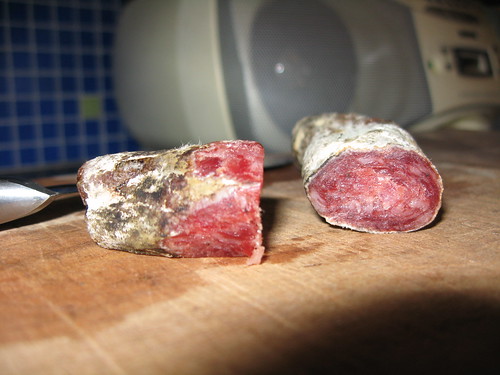
If I were Bourdain, I would've bit in with gusto. I'm not. I trembled and felt I had to do it. It's now 3:45 and we're off to a 4-yr old birthday party. Wish me luck. It's been 5 minutes and I'm still alive.
Developing.
Update 14-Jul-2008
How was that suspense? No, didn't die, not even a twinge of stomach disruption. And, it tasted darn good.
My advisor in all things pork, Andrew, suspects it's a tad under-cured, because the innermost core of the sausage still looks a bit more moist than the outer ring of familiar dried sausage.
Some thoughts:
• I'll let the remainder hang in the humid environment and keep cutting them open for observation every couple months. This will be a learning batch.
• I think it was a reasonably good run; no rancidity observed at the temps/humidity.
• In the future, I will go one step further regarding safety and freeze per CDC recommendations to insure a higher level of safety. It's an easy step, no reason not to do it (although some French buthers would never freeze meat prior to processing).
• The way in which I pierced the casings was not good. I must use a PIN and not a knife point. Some of the sausage was funny shaped and it could have compromised the integrity of the casing during drying.
• I'm switching to fresh (not dry cured) sausage (sage and sweet Italian for starters) for additional experience with grinding and mixing techniques.
• The humidity fussing I did earlier was silly. From all I've read, more humid is better. Too much humidity only slows things down. I simply hung them on a hanger inside of a tall, clean trash bucket in which the bottom had a few inches of water. This environment, with the sausage curing gives a steady 80%+ relative humidity and my basement was about 65°F during the entire cure.
• Finally, I think I need much wider casings for the sausage since it shrinks a lot on curing.
• Definitely a project I will revisit!
7.09.2008
DIY Food Dehydrator v. 2: Cherries
The 2nd Version of my dehydrator is a keeper. Been cranking out some hefty sheets of fruit. Haven't stacked trays yet; still working out some details.
A couple years ago, our dear neighbors from our old neighborhood gave us a zillion sour cherries from their tree. The Mrs. pitted and tossed them in the freezer and that's where they've been - for at least a couple years.
The Mrs. was kind enough to let me have the fruit of her labor for a dehydrator challenge. I sugared them a bit (ca. 1/2 C per huge batch shown) and lay them out for a dehydration session. They were really wet and soupy. Took about a week. But they didn't stick together, didn't get moldy. They turned out slightly tacky, well-separated and tasted like no dried cherry I've ever experienced. And, better than fresh. Check 'em out.
7.06.2008
Grilling Veggies: flip flop
Recently, I've had the good fortune to become better acquainted with Jim, Zach (Jim's associate who produces podcasts on Columbus Food.tv and, of course, Zach's lovely wife and fellow foodie, Mary. We've talked some fun food topics.
Most recently, we had a session discussion grilling veggies. I stated in the discussion I was content to grill veggies directly over coals, on the grate with no special utensils or pans.
The more definitive a statement I make, the more I am likely to think about it, question it, and change my mind. I think they call that flip flopping in the politics arena. Can't feel bad. Etched-in-stone habits are always healthy to challenge.
Back to the flip flop. We just got our share of veggies yesterday and I was cleaning greens and prepping veggies for the week ahead. The beets looked enticing; I thought roasting the beets and putting them on a bed of greens with a little feta and bread sounded perfect. I actually had never tried grilling veggies in a pan on the grill. Hmmm. I skinned the beats, chopped the zucchini, quartered an onion, tossed in some sliced basil and a couple slivers of garlic (all with a quick splash of olive oil and salt and pepper) and tossed the pan on the grate over the hot coals. Then, I went to walk the dog.
About 15-25 minutes later, bam! (ouch). They were gently smokey (I used Kingsford/hickory) and nicely browned. They cooled a bit and were tossed on the bed of greens. It was a lovely meal.
The shallow roasting pan was easier than tossing the veggies with a spatula and there was no chance of losing any in the grate, so the size of the dice didn't matter. I must also say, I use a pretty darkened thin roasting pan and don't bother to keep it shiny, it's clean but never looks it. I may never roast roots any other way again.
7.02.2008
Tahini Mixer (cordless)
Hoummus (I'll spell if a few different ways so I'll occasionally get it right) is one of the most popular staples in our repertoire. Simple, healthy and fast to prepare. And, the kid likes it. One problem. The critical ingredient, tahini, like most nut butters, separates on standing. This makes it tricky to pour or portion it into a recipe. Are you getting oil or the nut paste when poured? If it were mixed uniformly, this wouldn't be an issue.
I always wanted to bring my tahini to the paint store so they could shake it on the paint stirring shaky thing. I just wasn't bold enough to actually do this so I tried to figure out a way to do it at home. The first thing I thought of was an immersion mixer. Problem with this is there's too much surface area and I figured the sticky tahini would adhere all over it ending up in a mess. The impeller in this application needed to have minimal surface area so the really sticky hummus wouldn't stick all over it.
I have these sharp, metal kebab skewers sitting in our infamous household "junk drawer." I don't use them for anything. I once brandished a bunch of the spikes when greeting a Jehovah’s Witness at the door trying to give me some Watch Tower shit, but that's about it. Suddenly, it hit. The loop at the end looked like a perfect impeller for this task. I grabbed my charged drill and gave it a whirl. In seconds, I had an extremely uniform tahini. When I pulled out the stirrer arm, it was nearly free of tahini.
I'm filing the process patent application tomorrow.
6.29.2008
DIY Food Dehydrator v. 2
Often the best solutions aren't sophisticated. My first dehydrator was more elaborate than it needed to be. A process improvement was in order.
A better solution would simply bathe many trays with warm, moving air at a temperature between 85°F and 140°F. I wanted to scale up the operation (stackable trays). The previous design's airflow was fast and the air several inches over the hotplate wasn't as warm as the air closest to the heat source, thus limiting the capacity. The depicted "vertical" form of heat and a gentler fan was easily achieved with a simple space heater (off season price at thrift store, $4). The fan is gentler and the heat adjustable. With the middle setting, I was able to maintain a steady 92-95°F. Click the image for a better detail view. I'm currently doing two trays and see no reason I couldn't use at least 5-7 with the proper configuration of trays (still some work on that needed).
6.23.2008
La chien a mangé ma saucisse.
We're about a week and a half into the big dry curing experiment for my saucisson sec. Despite a fleeting fear that my saucisson was getting a bad mold (according to Len Poli, they're OK), things were going swimmingly.
The other day, the Mrs. and I were busily running around trying to get a bunch of stuff done. Suze was just hanging around watching us (foreshadowing - Suze usually sleeps). As we were running about, I noticed Suze was missing. I walked into the basement. Upon entering the basement, I noticed a beautiful burst of fresh-smelling sausage. Hmmm. I thought the aroma was settling down as the curing was progressing. Interesting (foreshadowing again).
I walked into the narrow, dark, humid hallway I call Sausage Curing Row and noticed, in a ray of artificial light, my dog leaning out a bit to make eye contact with me. She looked nervous. She always looks nervous. She looked a tad distressed. She always looks distressed. But, something was different. I was worried and went to see if she was alright.
She was fine. Really fine.
She smelled like garlic and I'm not sure, but I think she was smiling. Sausages were all over the floor and Suze had ravaged one of them. I rescued the poor little guys and realized only one had been violated. In the scuff, another had popped off the chain and fell in the water supplying the requisite high humidity. Suze ran away, a tad frustrated, and I scrambled to put the remaining saucisson back in the curing position with the barrier in place - that I removed that morning for some unknown reason. I managed to salvage about two thirds of the supply and left them to rest. Time will tell if we get any after another couple weeks.
6.19.2008
Pears, dehydrated and yummy
I'll be updating this post intermittently with bits of dried fruit from my nifty dehydrator. I've tweaked it a bit, but generally the same as initially disclosed. Just have to start stacking trays to do more in one run. I may have to put the hot plate so the element is vertical if I do this stacking thing.
6.18.2008
In which I become a sausagemaker (so the mrs won't be embarrassed by my former title even though my masculinity was never threatened) - updated
I needed to pierce the casings to let these dehydrate during their dry curing. I pierced using a knife tip. I didn't realize how much pressure these things were under, but they oozed meat in some places. I was supposed to use a pin. When I did - on some of them - things were fine. No oozing. Oh well. Only a few bucks invested. We'll see how they come out.
Now, the tough part. Waiting. Temps in the basement are a tad high, ca. 65°F and ca. 65-73%RH. They are supposed to be finished when very firm and have lost 30% of their weight from dehydration. I will be testing one several days before unleashing them on friends. A coworker told me to have him on speed dial the day I try it so I can call for help if I need it. Thanks Larry.
It's supposed to take 3-4 weeks. I'll be updating this post with progress.
Day 8. Drying may be going well. The sausage is getting much more dense (losing moisture). The greenish spots on the exterior are worrying me. Although, I've never watched the intermediate steps of a dry cure before. The outer skin is getting whitish which looks consistent with other dry cured sausages I've seen. Anyone have any thoughts on the green spots? Like mold on cheese? Still have a couple more weeks and, despite the weather, we've maintained low 60's temperature and 70%RH +/-. Stay posted.
6.14.2008
DIY Fruit Dehydrator v. 1
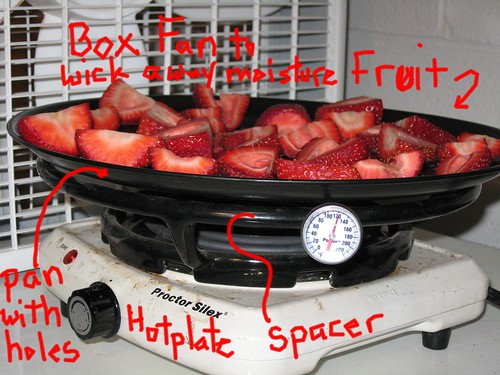
The other day, a coworker generously shared a piece of homemade strawberry fruit leather; it was sublime. Trader Joe's might sell these things for a quarter, but the descriptor 'leather' is apt. A well prepared nugget of dried fruit is a treat. Thanks Fred, I'm not worthy.
The light bulb went off. Scanning Ebay and Amazon for a dehydrator was my first move. Way too expensive for an initial attack. I read these devices operate at 85°F to ca. 100+°F and require a fan, presumably to wick away the moisture as the fruit dries. Seemed easy enough.
To the basement! I purchased some of those nearly tasteless California strawberries for my pilot runs and used the setup shown in the image. An inexpensive 800W hot plate on a low setting with some heat diffuser/spacer and a tray holding the fruit. I set the hotplate to get a specific surface temperature and placed a box fan beside it to drive off the moisture. Some temperature measuring devices were placed about and I was ready to evaluate parameters.
The fruit leather is an ambitious target. I'll attempt that later. For now, dried strawberries. Why not images of the final product? From two large containers of strawberries, there are none left. I'll post them later, although they don't look particularly special.*
So far, the parameters for strawberries (I'll be editing this as refinements become available):
• fruit should be cut to maximize surface area and cut uniformly (slices seem to be good).
• drying surface temperature, 85-100°F, too hot and they get dark spots
• box fan, slow speed
• drying time, ca. 24 hours, seems flexible
• for fruit that can discolor prior to dehydrating, e.g., apples, pears, etc. I've used a couple treatments. 1. a bath of lemon juice and water is the most reliable. 2. I've also used (for apples) a bath of balsamic vinegar and brown sugar. Gives the fruit an interesting flavor.
... more to come
[note to self: The hot plate idea is ok, but the heat is localized on the bottom. If I wanted a vertical stack of trays, I'd need a vertical heat source with a fan, i.e., a space heater!!!, to the thrift store. 24-Jun-08: Just scored an inexpensive space heater with a large range of heat settings. I'll be trying this with a stacked set of drying trays. Results to follow.]
Related link
My new improved dehydrator. It's awesome.
*rant: I detest the phrase 'food porn' and urge this disgusting phrase be abolished from food bloggers' vernacular. I'm no prude, but even the casual association of something as special as food and porn is wrong.
6.09.2008
Scalpel ...

Weather is wreaking havoc with my basement environmental conditions. Temps are up (63-70°F) and relative humidity is nuts (63-70+%).
I have my pork cut up, materials gathered - curing salt, nitrile gloves, etc. And, the mixer is chilled, locked and loaded. Now, I have to figure out if the low 60's/60-70%RH is adequate or too moist for the dry cure. I may just make plain old sumptuous Italian sausage if I back out of the dry cure and save that for the winter when the basement environment is more stable.
6.06.2008
Vegetarian BBQ: Roasted* Medley on Greens
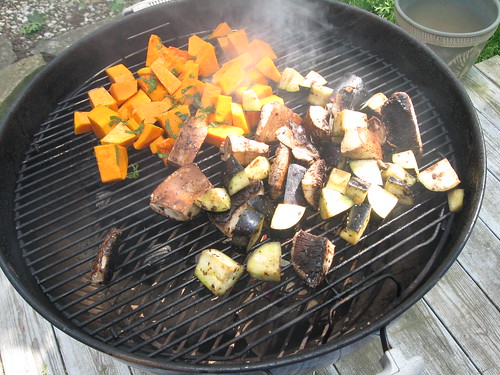
A while back, the amazing Jim of CMH Gourmand asked me during a podcast if I had any vegetable favorites on the grill. I had to pause a bit to think of the vegetables I grill; there are many more possibilities than I originally thought.
Tonight, I really wanted to serve up salad for the gang and I wanted something substantial. Fridays are usually pizza night - tough act to follow. I had a butternut squash lying around, then I picked up some eggplant, potabellos, baby greens and some Egyptian style Feta from Mediterranean Imports (the Egyptian Feta is like a slightly salty chevre, it's amazing - and cheap). I chopped the veggies in medium cubes, tossed them in a generous splash of olive oil, added salt and pepper and a big bunch of finely sliced sage and tossed it on a grill.
I used briquettes** stacked on one side (a large bunch) and spread the veggies all around the grill using an indirect method but had all the vents opened. Very hot. The grill was capped and I went to walk Suze. About 40 minutes later, I took a spatula and tossed the cooking veggies to mix them a bit. Surprisingly, the squash, shrooms and eggplant cooked well together. I let them go another few minutes and tossed them in a bowl to rest.
Finally, salad prep: beautiful roasted*/grilled veggies on a bed of greens speckled with feta, grape tomatoes and a light splash of Parmesan vinaigrette. Not the best image, but I think it captures the dish. Roasted vegetables, more common in winter, redone for summer dining.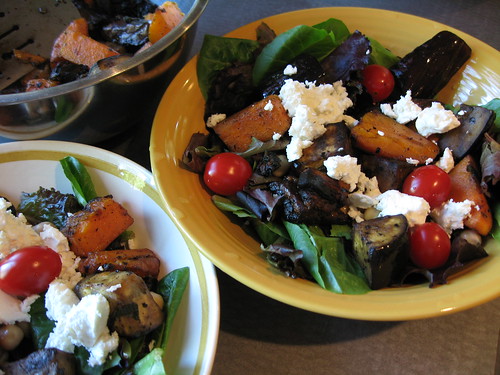
We'll be doing many more veggies this season. Thanks for putting that seed in my head Jim.
*I did mean roasted because the kettle is covered. A covered Weber/kettle provides even heating, much like a vented oven. It's baking, with smoke.
**I must retract a statement I made on the aforementioned podcast. I said briquettes, by themselves, afforded no smoke flavor. They indeed do. It took a vegetable to notice it.
On a related note, I've been meaning to get a new product; Kingsford briquettes embedded with hickory - they'd be killer all purpose fuel.
6.02.2008
Sausage, greens and beans
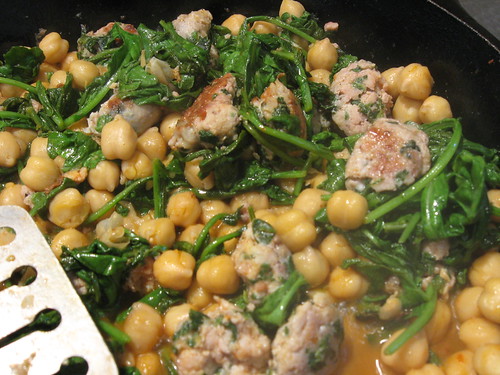
We usually have a special dinner on Sundays. We have a bit more time to think and plan the meal. This Sunday, however, like in past weekends, home improvement projects, landscaping, etc. left us a bit short on time for the dinner prep.
Saturday, I couldn't resist getting a couple chicken, spinach and Parmesan sausages (0.5 lb) from Weiland's. Didn't know what to do with them when I bought them. Sunday late afternoon crept around and, while cleaning out the hummingbird feeder, I sprung into action. I sauteed the sausage. When finished, I tossed in a strained can of chickpeas (Bush's), some baby arugula (12 oz, torn in shreds) and an additional touch of salt. I simmered it all for about 10 minutes, until most of the moisture from the leaves evaporated. Then, I let it cool a bit and served it up with ...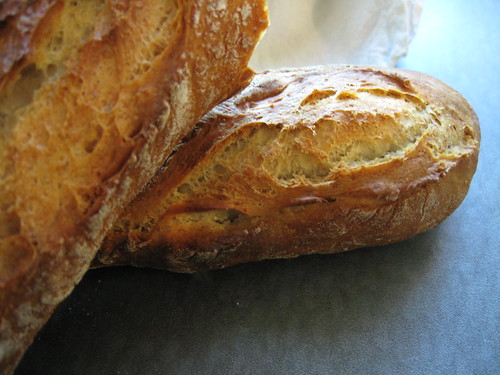
The nifty thing about this meal is the sausage provided all the seasonings for the entire dish simplifying the preparation. And, next time, we'd double the greens and chickpeas for the same amount of sausage.
